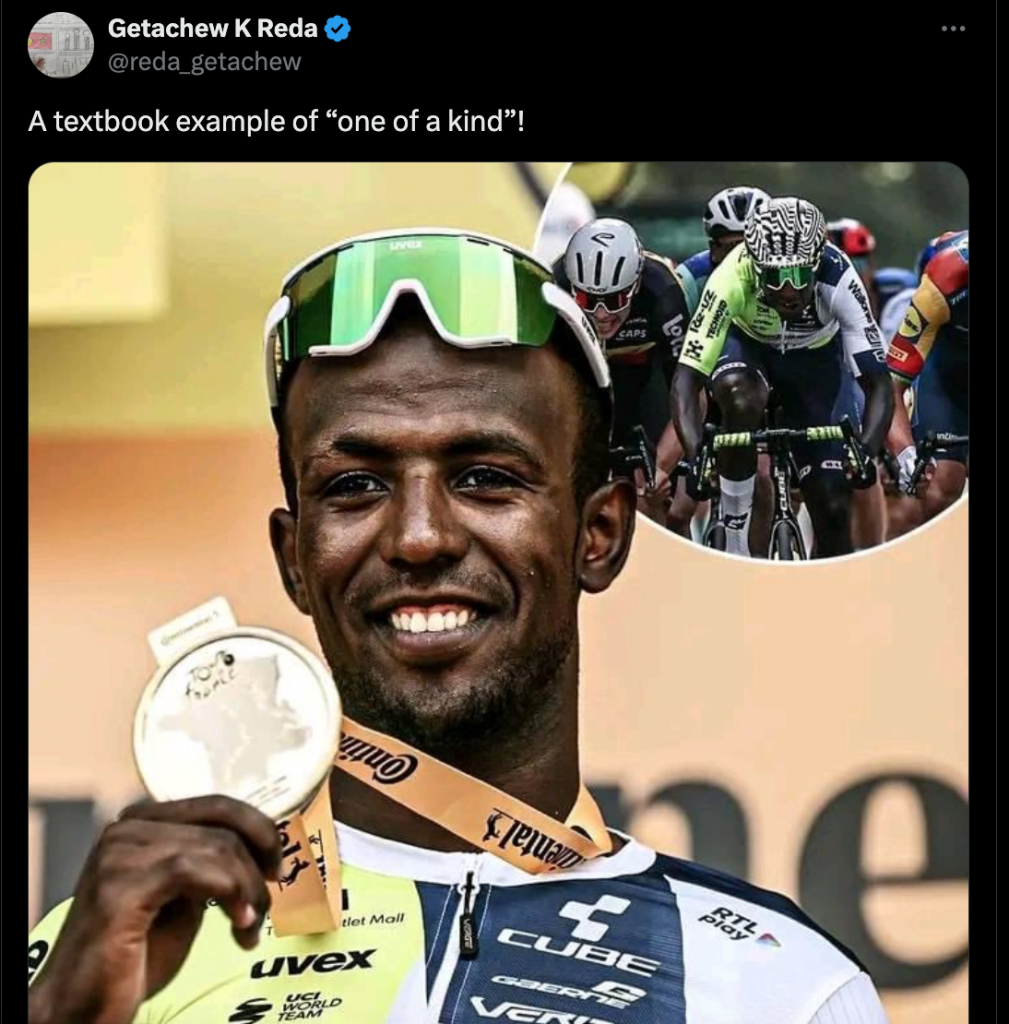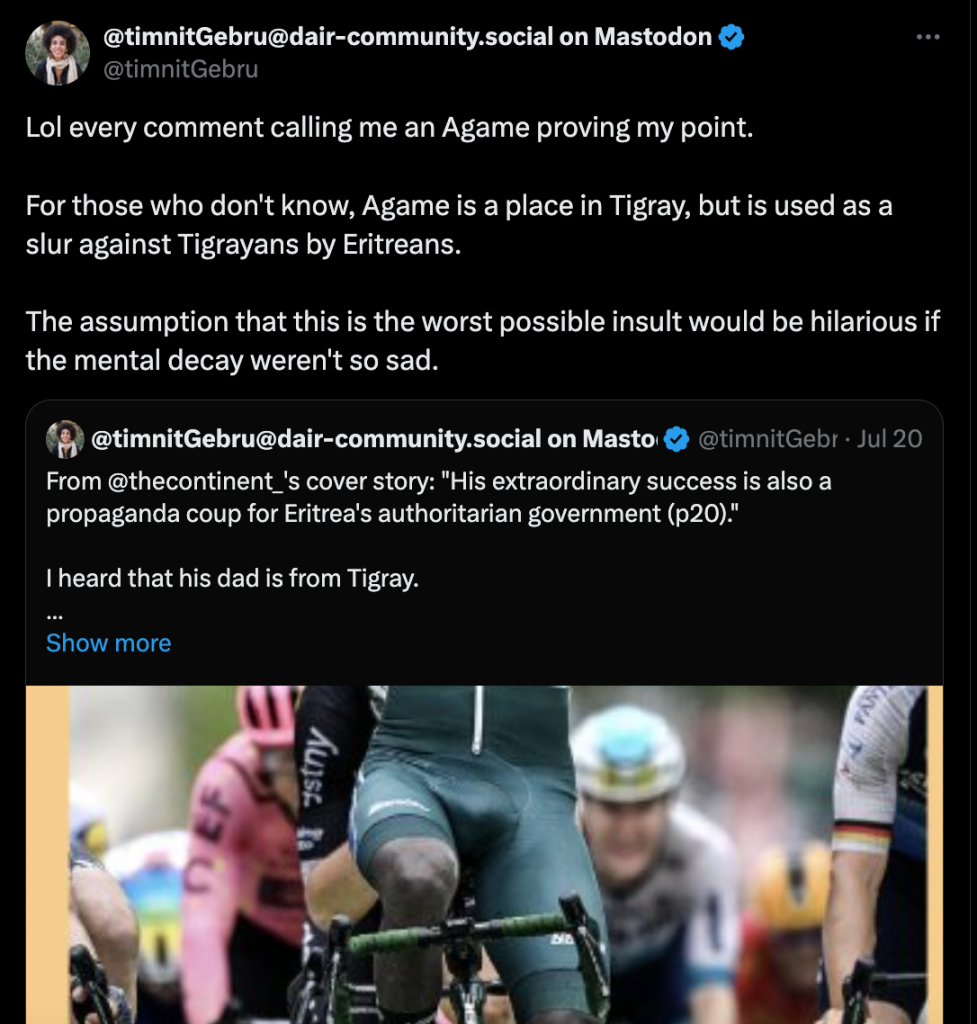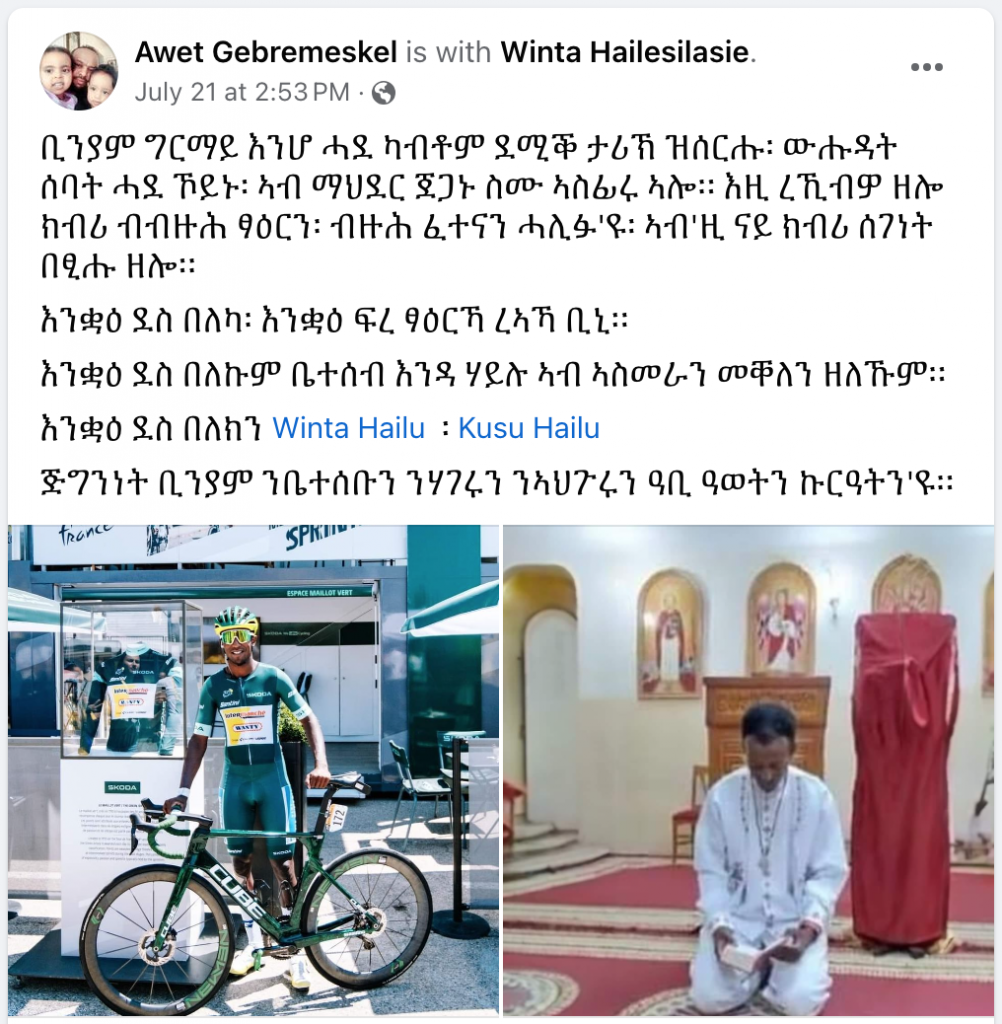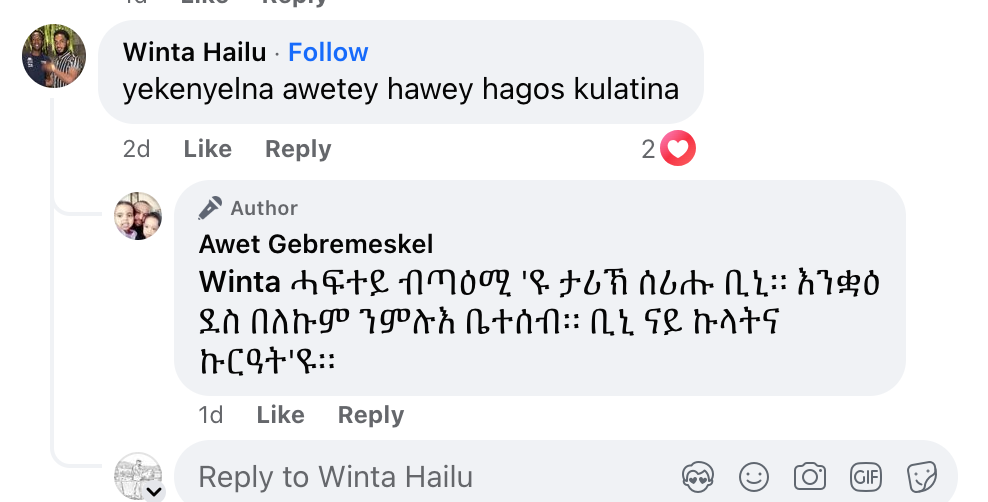Analysis
Is Tour de France Winner Biniam Girmay a Tigrayan? He engenders Identity Controversy
Published
1 year agoon
Biniam Girmay Hailu, a professional road cyclist who won the Green Jersey at the 2024 Tour de France, has engendered identity debate among Tigrayans and Eritreans, and Ethiopians. Many Tigrayans have expressed messages of congratulations. Some did so without mentioning his identity (see for example 1, 2, 3,4). Getachew Redda (the president of the Interim Administration Of Tigray) has also said this:

Many other Tigrayans, however, congratulated him, considering him both as a Tigrayan and their kin and making explicit claims that he is a Tigrayan (See for example 1, 2, 3 and 4).
All these, as everything between Tigrayans and Eritreans in particular, and Eritreans and Ethiopians in general, has resulted in heated social media exchanges where regime-affiliated Eritreans express anger at the fact that Tigrayans claimed Biniam is Tigrayan. An example of this can be seen under Timnit Gebru’s post and my own post.

Why does the simple claim of Biniam is Tigrayan or even a simple expression of congratulations by Tigrayans touch a chord with PFDJ-Eritreans? It goes to the heart of the Eritrean project.
The Eritrean project’s main preoccupation during the past 30 years has been about creating an Eritrean identity that is distinct from Ethiopia in general, but more importantly from Tigray and Tigrayans. Let’s unpack this.
Eritrea’s core ethnic group are the Tigrayans of highland Eritrea. They form about 50% of the Eritrean population, and are the single most dominant Ethnic group in Eritrea. But they are a minority in the greater Tigrayan population. Since time immemorial until recently, they have always been part of the Tigrayan polities, and they never saw themselves as different from Tigray and Tigrayans. That is why the Tigrayan general Alula Abba Negga from proper Tigray was able to administer Mereb Millash and to found Asmara as the capital of Mereb Millash, the then name of most of Eritrea. The Italians and later the EPLF and PFDJ (the colonial ideological inheritors) tried to cleanse Asmara and Eritrea of the legacy of Alula in particular and of the Tigrayans in general. They changed the name of the area in Asmara where Alula used to live from inda Raesi (which refers to Alula), and the name of the airport from Emperor Yohannes to Asmara Airport, and demolished Alula’s monument in Dogali.
Some 130 years ago, the Italians together with the Ethiopian king of Shewa Menelik divided the Tigrayans and created a border between them. Many Tigrayans from proper Tigray who went to Asmara with Alula remained in Asmara and many more Tigrayans, driven by subsequent oppressive Shewan rule and policy of impoverishment, and lured by prospects of work in colonial Eritrea went to Asmara, making the city primarily a city of Tigrayans from proper Tigray. They built the Habesha quarter of Asmara (Abba Shawul area, which is named after an Alula official’s name) first and the European quarter as laborers under the Italians. They also built Enda Mariam Cathedral of Asmara in imitation of the head cathedral of Enda Mariam in Aksum. Many prominent Eritreans including General Aman Andom, Weldeab Weldemariam and Isaias Afewerki have their roots in proper Tigray. While Weldeab Weldemarima openly and proudly said he is a Tigrayan from Tigray when he was accused of being Tigrayan, Isaias Afewerki on the other hand, is deeply ashamed of having roots in Tigray. Below is a text from a former Eritrean ambassador, Andebrhan Welde Giorgis’s book:
“Isayas presides over a society where self-identity is deeply rooted in paternal ancestry and which, despite its enthusiastic initial embrace, he knows he has alienated and no longer accepts him. He has thus turned a non-issue into an abuse in his mind’s eye, because of which he suffers from a rejection complex verging on an identity crisis that occasionally surfaces when under the influence of alcohol or seized of drunken brawls.” He adds the following in a footnote: “In one incident, Isayas blurted, ‘I know that you call me Agame behind my back. I will show you! I will take this country down as I put it up.’”
Isaias Afewerki, having grown under the stigmatizing and racial slurs and labels of Agame and Tigrayan in Asmara, has grown to believe that he has to always prove himself that he is not one, which explains the extreme hate and wars against Tigrayans.
First cultivated by colonial Italy for the sake of making it easy to consolidate colonial rule, and later, due to the colonial embellishments, a sense of being superior and advanced as opposed to the new impoverished newcomers from Tigray started to emerge among especially the Tigrayans of Asmara. This sense was later strengthened by the continued influx of impoverished and destitute Tigrayans fleeing oppression and impoverishment in Shewa-dominated new Ethiopia, and more importantly the famines that hit Tigray the hardest during the Haileselassie and the Derg eras. The Tigrayans of Asmara who were in a relatively better living standards started to find it hard and humiliating to associate themselves or to believe they share the same identity with the destitute newly arriving Tigrayans, and started imagining a new identity, distinct from Tigrayans. This reimagining of a new identity distinct from Tigrayans has been the main feature of the Eritrean project and its implementation, and a source of problems for Tigray-Eritrea relations in particular, and for Ethiopia-Eritrea relations in general.
The maintenance and perpetuation of distinction from Tigray and Tigrayans is the main identity marker that the Eritrean regime invests a lot in and fiercely guards with all its might. This, sometimes, reaches ridiculous levels such as banning certain commonly used Tigrinya words to create easily identifiable markers, continuously portraying the Tigrayan as destitute, perfidious and evil, turning Tigrayan place names (such as Agame) into derogatory slurs, shaming and ostracizing any Eritrean who admits having roots in Tigray, mocking Tigrayan accents, and embarking on a genocidal war against Tigray in order to reverse any progress and maintain and create on the ground the image of destitute Tigray and Tigrayans that has been engraved in the Eritrean mind, as part of his/her main feature of identity: “you are Eritreans, because you are way more advanced than the destitute Tigrayan”. To their dismay, they found this hard to maintain as the emaciated and illiterate Eritreans crossed the border a decade or two later only to be awed and confused by developments in Tigray and in Ethiopia in general. That image of an Eritrean starring with awe in developments in Tigray was deeply humiliating for the engineers of Eritrean identity and worth waging a genocidal war, and the Isaias regime did it in collaboration with the traitorous Abiy Ahmed. The Eritrean leaders’ fear of Tigray and Tigrayans is, however, so deep and it is exacerbated by the fact that more and more prominent young Tigrayans from Eritrea continue to openly assert they are Tigrayans (see for example, Yosief Gebrehiwet, and Tesfom Mehari) or as they call for Tigray-Eritrea close relations. These developments send shivers down the Eritrean leaders’ spines.
So is Biniam Girmay really a Tigrayan?
If we are speaking about identity, sure he is a Tigrayan, from Eritrea. The PFDJ-Regime has given the Tigrayans in Eritrea the ridiculous and laughable name of “Tigrinya”, again for the sole purpose of separating them from Tigrayans. The ‘nya’ at the end of Tigrinya (itself an Amharic word by origin) is an Amharic sound, and is used only to name languages and never people. It is a recent introduction to the language of the Tigrayans, and a new name for the language of the Tigrayans, let alone it being the name of a people. The language of the Tigrayans was until recently called simply Tigray (also spelled Tigrai), among other names, and the people are called Tigrayans or Habesha or Ag’azian.
Some of the claims that Biniam is a Tigrayan are therefore simply asserting Tigrayanness as an identity, and in response to the Eritrean project. As such these claims are simply saying he is a Tigrayan by identity, and an Eritrean by citizenship. Many claims of Biniam’s Tigayanness from Tigrayans from both Tigray and Eritrea fall under this category (see for example the posts from Yonas Habteslasie and Tesfom ).
But there is more to the debate. Many people have expressed that Biniam’s father is from proper Tigray (Aksum to be precise) and that he still doesn’t even have an Eritrean citizenship (see 1, 2, 3, 4). Two claims are especially strong. A person by the name Awet on facebook congratulates Biniam and mentions his family members in Tigray as follows, and one of the family members mentioned by name responds confirming his roots in Tigray.


Another claim is by a prominent Eritrean priest, Priest Markos Debbas, who claims in a video that both Biniam’s parents are from Tigray and that his father does not even have Eritrean citizenship. Take a listen below.
Tigrayans who claim Biniam is Tigrayan in the narrower sense of him having roots in proper Tigray are therefore referring to this. As Eritreans are very quick to claim anybody who shines (even pre-Eritrean figures, second generation Eritreans, or even ridiculously Pushkin on the basis of having roots in Eritrea) as theirs, Tigrayans wonder why can’t someone with roots in Tigray and who grew up in Eritrea be called Tigrayan then?
Bouts of identity debate between Tigrayans and PFDJ-Eritreans are common. At the heart of the debates are the history of the same people divided by artificial colonial borders and the Eritrean identity project which considers hating and denigrating Tigrayans as the core of its identity marker. The fact that it is a sensitive issue for PFDJ Eritreans and always touches a chord is also a reason for many Tigrayans to poke at it once in a while.
It is, therefore, for the politics behind it that Tigrayans have claimed Biniam as a Tigrayan. Otherwise, Tigrayans don’t have much zeal for claiming even those that are their own as their own. Many Tigrayan athletes have, for example, shined in recent times as Ethiopians, but Tigrayan celebrations or claims were not seen.
The Eritreans are known to denigrate and disown any Eritrean who defects, criticizes the regime, expresses having roots in Tigray or sympathizes with Tigrayans. Biniam, aware of this and fearing for the safety of his family members in Eritrea, will probably not openly express his Tigrayanness any time soon, but it may happen one day. If that happens, those who are claiming him as an Eritrean hero will be found disowning him and denigrating him.
Gebrekirstos Gebremeskel is a researcher, runs http://mermru.com (NLP resources & tools), and manages Tghat. He is interested in science, history of ideas and the politics of the Horn.

Negasi Kokob
July 27, 2024 at 12:47 pm
Great analysis
Bahregasi
July 25, 2024 at 12:25 pm
Well documented bro, I like Biniam Grmay but I disappointed he didn’t say any word about his identity why he is ashamed be a proud Tigrayan ,that’s embarrassing point from a professional cyclists,
Daniel
July 24, 2024 at 8:37 pm
Great piece
Zemelak
July 24, 2024 at 2:34 pm
well articulated analysis as always .
happy to see you here since you left Facebook.
Girmay Berhane
July 24, 2024 at 11:44 am
Very excellent article. Thank you very much Gerekistos Hawey!
Aron
July 24, 2024 at 7:39 am
Superb job. Your analysis touches upon the root cause of the perpetual feud between the two neighbours. I have learned why the people from Eritrea feel that way, it has been an enigma for me why they feel superior to their brothers on the other side of the Mereb river being a person from a different era.